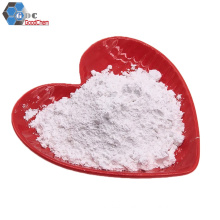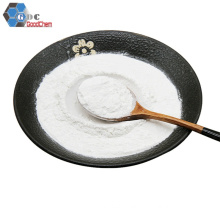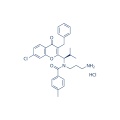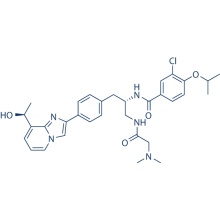.cp_wz tabla {borde superior: 1px sólido #ccc; borde izquierdo: 1px sólido #ccc; } .cp_wz table td {borde derecho: 1px sólido #ccc; borde inferior: 1px sólido #ccc; padding: 5px 0px 0px 5px;} .cp_wz table th {border-right: 1px solid #ccc; border-bottom: 1px solid #ccc; relleno: 5px 0px 0px 5px;} \ n Peso molecular: \ n 553.52 SB743921 es un inhibidor de la proteína del huso de kinesina (KSP) con Ki de 0.1 nM, casi sin afinidad por MKLP1, Kin2, Kif1A, Kif15, KHC, Kif4 y CENP- MI. Fase 1/2. \ N Actividad biológica La Ki de SB 743921 para KSP humano y de ratón es 0,1 nM y 0,12 nM, respectivamente, mientras que la Ki de SB 743921 para otras quinesinas, incluida MKLP1, Kin2 es más de 70 µM. SB 743921 bloquea el ensamblaje de un huso mitótico funcional, lo que provoca la detención del ciclo celular en la mitosis y la posterior muerte celular. SB-743921 tiene una potencia mejorada sobre ispinesib en ensayos bioquímicos y celulares. SB-743921 es de mayor eficacia in vivo contra la leucemia P388. SB-743921 tiene una eficacia significativa en un amplio espectro de modelos tumorales que difieren del de los taxanos. Se ha demostrado que SB-743921 tiene actividad contra xenoinjertos de tumores humanos avanzados Colo205 (regresiones completas), MCF-7, SK-MES, H69, OVCAR-3 (regresiones completas y parciales) y HT-29, MX-1, MDA- MB-231, A2780 (retraso del crecimiento tumoral). SB-743921 no causa la neuropatía que a menudo se asocia con los agentes de tubulina. Protocolo (solo como referencia) Ensayo de quinasa: [2]
|
Biochemistry assay
|
The motor domains of KSP (amino acids 1–360) is expressed as in Escherichia coli BL21(DE3) as COOH-terminal 6-his fusion proteins. Bacterial pellets are lysed in a microfluidizer with a lysis buffer [50 mM Tris-HCl; 50 mM KCl, 10 mM imidazole, 2 mM MgCl2, 8 mM β-mercaptoethanol, 0.1 mM ATP (pH 7.4)], and proteins are purified using Ni-NTA agarose affinity chromatography, with an elution buffer consisting of 50 mM PIPES, 10% sucrose, 300 mM imidazole, 50 mM KCl, 2 mM MgCl2, mM β-mercaptoethanol, and 0.1 mM ATP (pH 6.8). Steady-state measurements of ATPase activity are performed with a pyruvate kinase–lactate dehydrogenase detection system that coupled the appearance of ADP with oxidation of NADH. Absorbance changes are monitored at 340 nm. All biochemical experiments are performed in PEM25 buffer [25 mM Pipes/KOH (pH 6.8), 2 mM MgCl2, 1 mM EGTA] supplemented with 10 μM SB 743921 for experiments involving microtubules. Rates of ADP release are measured in a stopped-flow apparatus; the decrease in fluorescence of MANT-ATP is monitored. Rates of Pi release are measured in a stopped-flow apparatus, using bacterial phosphate binding protein modified with 7-diethylamino-3-((((2 maleimidyl)ethyl)amino)carbonyl)coumarin (MDCC) dye. Ki estimates of KSP inhibitors are extracted from the dose–response curves, with explicit correction for enzyme concentration. Tubulin polymerization by measuring changes in absorbance at 340 nm is monitored. The assay is performed in 100-μL volumes in 96-well half-area microtiter plates, using a microplate reader with the incubation temperature set at 37 °C.
|
Ensayo celular: [2]
|
Cell lines
|
HeLa cells
|
|
Concentrations
|
~1 μM
|
|
Incubation Time
|
24 hours
|
|
Method
|
All cells including HeLa cells are cultured in 10% FCS in RPMI 1640 in 5% CO2. We assessed 48-hour growth inhibition by serial dilution of SB 743921 relative to DMSO-treated cells in 96-well microtiter plates, using 3-(4,5-dimethylthiazol-2-yl)-5-(3-carboxymethoxyphenyl)-2-(4-sulfophenyl)-2H-tetrazolium. Cell growth is represented as the ratio of absorbance of treated cells to DMSO control, plotted by concentration and fitted to a four-parameter curve. Concentrations at which cellular growth is inhibited by 50% are extrapolated from the curve fit. The DNA content of HeLa cells cultured in the presence or absence of 1 μM SB 743921 for 24 hours is assessed by propidium iodide staining and flow cytometry. Immunofluorescence images are collected of HeLa cells treated for 24 hours with 1 μM SB 743921, fixed with 2% formaldehyde, permeabilized, and stained with DM1-α, anti-γ-tubulin, and 1 μg/mL 4′,6-diamidino-2-phenylindole, and with Alexa 488 secondary goat antirabbit IgG and Rhodamine-X goat antimouse IgG. Images are collected with a DeltaVision Restoration Microscopy System at a magnification of ×600. Z stacks (0.2 μm) are collected, and out of focus information is removed by constrained iterative deconvolution. Z stacks are then compressed into to a single image plane.
|
Estudio con animales: [1]
|
Animal Models
|
Female BDF1 mice with P388 lymphocytic leukemia cells
|
|
Formulation
|
2% dimethylacetamide + 2% Cremophor EL + 96% acidified water [pH 5.0]
|
|
Dosages
|
7.5 mg/kg- 30 mg/kg
|
|
Administration
|
Administered via i.p.
|
|
Solubility
|
Saline pH5.0,
30 mg/mL
|
|
* Please note that Selleck tests the solubility of all compounds in-house, and the actual solubility may differ slightly from published values. This is normal and is due to slight batch-to-batch variations.
|
Conversión de diferentes modelos de animales basados en BSA (valor basado en datos del Borrador de Directrices de la FDA)
|
Species
|
Baboon
|
Dog
|
Monkey
|
Rabbit
|
Guinea pig
|
Rat
|
Hamster
|
Mouse
|
|
Weight (kg)
|
12
|
10
|
3
|
1.8
|
0.4
|
0.15
|
0.08
|
0.02
|
|
Body Surface Area (m2)
|
0.6
|
0.5
|
0.24
|
0.15
|
0.05
|
0.025
|
0.02
|
0.007
|
|
Km factor
|
20
|
20
|
12
|
12
|
8
|
6
|
5
|
3
|
|
Animal A (mg/kg) = Animal B (mg/kg) multiplied by
|
Animal B Km
|
|
Animal A Km
|
Por ejemplo, para modificar la dosis de resveratrol utilizada para un ratón (22,4 mg / kg) a una dosis basada en el BSA para una rata, multiplique 22,4 mg / kg por el factor Km para un ratón y luego divida por el factor Km para una rata. Este cálculo da como resultado una dosis equivalente para ratas de resveratrol de 11,2 mg / kg.
|
Rat dose (mg/kg) = mouse dose (22.4 mg/kg) ×
|
mouse Km(3)
|
= 11.2 mg/kg
|
|
rat Km(6)
|
Información química
|
Molecular Weight (MW)
|
553.52
|
|
Formula
|
C31H33N2O3.HCl
|
|
CAS No.
|
940929-33-9
|
|
Storage
|
3 years -20℃Powder
|
|
6 months-80℃in solvent (DMSO, water, etc.)
|
|
Synonyms
|
|
|
Solubility (25°C) *
|
In vitro
|
DMSO
|
111 mg/mL
(200.53 mM)
|
|
Water
|
22 mg/mL
(39.74 mM)
|
|
Ethanol
|
111 mg/mL
(200.53 mM)
|
|
In vivo
|
Saline pH5.0
|
30 mg/mL
|
* <1 mg/ml means slightly soluble or insoluble.
* Please note that Selleck tests the solubility of all compounds in-house, and the actual solubility may differ slightly from published values. This is normal and is due to slight batch-to-batch variations.
|
|
Chemical Name
|
(R)-N-(3-aminopropyl)-N-(1-(3-benzyl-7-chloro-4-oxo-4H-chromen-2-yl)-2-methylpropyl)-4-methylbenzamide hydrochloride
|
Calculadora de molaridad Calculadora de dilución Calculadora de peso molecular
Grupos de Producto : Señalización citoesquelética > Inhibidor de kinesina








